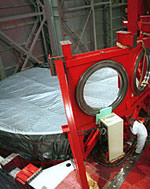
Image credit: UA
The University of Arizona today announced that the first 8.4-meter (27-foot) primary mirror for the world?s most powerful telescope, the Large Binocular Telescope (LBT), has successfully been installed in the telescope structure at Arizona?s Mount Graham International Observatory (MGIO).
The 18-ton mirror made its 150-mile journey from Tucson to the top of Mount Graham near Safford, Ariz., in October 2003. Now the mirror has been installed in the telescope, and technicians are testing intricate mirror support system hardware and software in preparation for telescope “first light.” First light, or when the mirror collects its first celestial light, is expected later this year.
The deeply parabolic mirror was cast and figured at the University of Arizona?s renowned Steward Observatory Mirror Lab and is the first of two identical giant mirrors that will make up the LBT. The mirrors are much larger and lighter than conventional solid-glass mirrors used in the past. Both together are valued at $22 million.
Each LBT mirror is a “honeycomb” structure made out of borosilicate glass that was melted, molded, and spun into shape in a specially designed rotating oven. Once cast, the first mirror was polished to near perfection using the Mirror Lab’s innovative “stressed-lap” technique. The mirror surface matches the desired shape to within a millionth of an inch over its entire surface. The Mirror Lab is currently polishing the second primary mirror.
After the first mirror was moved to the telescope structure late last year, engineers spent more than two months testing and perfecting mirror installation procedures using a dummy mirror in the actual mirror “cell,” or mirror support structure. The mirror was then installed in the cell and, in precise operations that required maneuvering the mirror and cell through a hatchway between building floors with only inches to spare, LBT workers lifted the mirror onto the telescope structure. The telescope is housed in an innovative 16-story rotating enclosure.
John M. Hill, LBT Project director, said, ?This is a huge step in what has been a very long and challenging process and would not have been possible without the support of a great team. From construction of our unique telescope structure to the implementation of this massive mirror, every step has involved great minds using cutting-edge technology. The remarkable success we have had so far is a tribute to the creative efforts of our team members.?
Work on the $100 million LBT project began with construction of the telescope building in 1996 and will be completed in 2005. The project is entirely funded by the LBT Corp., an international consortium of scientific and academic institutions. When the LBT is fully operational, it will be the world?s most technologically advanced optical telescope, creating images expected to be nearly 10 times sharper than images from the Hubble Space Telescope.
Peter A. Strittmatter, president of the LBT Corp., said, ?The twin mirrors of the LBT will have the light gathering capabilities of an 11.8 meter (39-foot) conventional telescope. This is an exciting time for everyone who has been involved in this pioneering effort. The LBT will provide unprecedented views of our universe, including for the first time, the ability to image planets far beyond our solar system. I believe this is the first of the next generation of extremely large telescopes and will signal the beginning of a new golden era in this type of space exploration.?
The LBT project is managed by the LBT Corp., a partnership that includes the University of Arizona; Ohio State University; the Research Corp.; the LBTB, a German consortium of astronomical research institutes; and the INAF, the Italian National Institute for Astrophysics. The LBT Corp. was established in 1992 to undertake the construction and operation of the LBT.
Original Source: UA News Release
